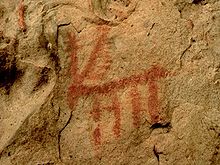Schematic Iberian art
Schematic Iberian art (also Arte esquemático ibérico or Pintura esquemática) are mainly painted, prehistoric representations on the Iberian Peninsula , which are almost always found in caves . They are associated with the first metallurgical cultures ( Chalcolithic , Bronze Age (2000 to 1500 BC)) and as marginal remnants at the beginning of the Iron Age .
The chronology, however, is controversial. From the 4th to the 1st millennium BC BCE, Schematic Iberian Art, initially overlapping with Levantine Art (Arte Levantino) in eastern Spain, occurs and reaches very late stages in remote areas. The main feature and name-giving is the figurative style, in which only the basic elements of the figures are shown. The presentation is so basic that the graphic elements become mere sketches without losing the identifying features. The figures are shown schematically with very safe lines. Men carry hats, shields, spears and sticks. The red color is also the most important of this period.
The schematic phenomenon is part of a movement that encompasses almost all of Europe and the Mediterranean region.
literature
- Eduardo Ripoll: Historia del arte de España. Lunwerg, SL, Barcelona 1996 ISBN 84-7782-393-6 .


